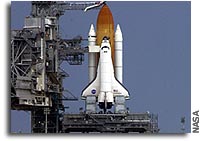STS-107 Launch Time Announced for Jan 16

Managers today confirmed the launch of Space Shuttle Columbia for Thursday,
Jan. 16 at 10:39 a.m. EST. The launch window extends for 2 hours and 30
minutes. This announcement comes following a final review of Shuttle
processing activities and a satisfactory engineering analysis of the Ball
Strut Tie Rod Assembly (BSTRA).
STS-107 is a scheduled 16-day mission with a planned KSC landing at about
8:53 a.m. EST on Saturday, Feb. 1.
This mission is the first Shuttle mission of 2003. Mission STS-107 is the
28th flight of the orbiter Columbia and the 113th flight overall in NASA’s
Space Shuttle program.
Mission STS-107 is an international mission devoted to space research, the
first dedicated research mission to be flown by the Shuttle in almost three
years. Columbia will carry in its payload bay the SPACEHAB Research Double
Module, a pressurized environment accessible to the crew. The module and the
Shuttle’s middeck will hold most of the mission’s more than 80 experiments –
involving more than 70 scientists worldwide – that will investigate space,
life and physical sciences.
The STS-107 crew includes Commander Rick Husband, Pilot William McCool,
Mission Specialists David Brown, Laurel Clark, Kalpana Chawla and Michael
Anderson, and Payload Specialist Ilan Ramon with the Israel Space Agency.
(end of general release)
REMAINING COUNTDOWN MILESTONES
*all times are Eastern
Launch-1 Day (Wednesday, Jan. 15)
(As of 11 a.m. EST, the countdown clock is in a scheduled built-in hold at the T-11 hour mark)
- Flight crew equipment late stow
- Move Rotating Service Structure (RSS) to the park position (about 4 p.m.)
- Perform ascent switch list
- Fuel cell flow-through purge complete
Resume countdown at T-11 hours (8:19 p.m.)
- Activate the orbiter’s fuel cells (9:34 p.m.)
- Clear the blast danger area of all nonessential personnel
- Switch Columbia’s purge air to gaseous nitrogen (10:19 p.m.)
Launch Day (Thursday, Jan. 16)
Enter planned 1-hour built-in hold at the T-6 hour mark (1:19 a.m.)
- Launch team verifies no violations of launch commit criteria prior to cryogenic loading of the external tank
- Clear pad of all personnel
- Begin loading the external tank with about 500,000 gallons of cryogenic propellants (as early as 1:49 a.m.)
Resume countdown at T-6 hours (2:19 a.m.)
- Complete filling the external tank with its flight load of liquid hydrogen and liquid oxygen propellants (about 4:49 a.m.)
- Final Inspection Team proceed to launch pad
Enter planned 2-hour built-in hold at T-3 hours (5:19 a.m.)
- Perform inertial measurement unit preflight calibration
- Align Merritt Island Launch Area (MILA) tracking antennas
- Perform open loop test with Eastern Range
Resume countdown at T-3 hours (7:19 a.m.)
- Complete close-out preparations in the white room
- Check cockpit switch configurations
- Begin Eastern Range final network open loop command checks
- Primary ascent guidance data is transferred to the backup flight system
- Complete inertial measurement unit preflight alignments
Enter planned 10-minute hold at T-20 minutes (9:59 a.m.)
- NASA Test Director conducts final launch team briefings
- Transition the orbiter’s onboard computers to launch configuration
- Start fuel cell thermal conditioning
- Close orbiter cabin vent valves
- Transition backup flight system to launch configuration
Resume countdown at T-20 minutes (10:09 a.m.)
Enter estimated 10-minute hold at T-9 minutes (10:20 a.m.)
- Launch Director, Mission Management Team and NASA Test Director conduct final polls for go/no go to launch
Resume countdown at T-9 minutes (about 10:30 a.m.)
- Start automatic ground launch sequencer (T-9:00 minutes)
- Retract orbiter crew access arm (T-7:30)
- Start mission recorders (T-6:15)
- Start Auxiliary Power Units (T-5:00)
- Arm SRB and ET range safety safe and arm devices (T-5:00)
- Start liquid oxygen drainback (T-4:55)
- Start orbiter aerosurface profile test (T-3:55)
- Start main engine gimbal profile test (T-3:30)
- Pressurize liquid oxygen tank (T-2:55)
- Begin retraction of the gaseous oxygen vent arm (T-2:55)
- Fuel cells to internal reactants (T-2:35)
- Pressurize liquid hydrogen tank (T-1:57)
- Deactivate SRB joint heaters (T-1:00)
- Orbiter transfers from ground to internal power (T-0:50 seconds)
- Ground Launch Sequencer go for auto sequence start (T-0:31 seconds)
- SRB gimbal profile (T-0:21 seconds)
- Ignition of three Space Shuttle main engines (T-6.6 seconds)
- SRB ignition and liftoff (T-0)








